
Forager
Installation view
2023. Photo: Tatu Kantomaa

Canals
50x30x5cm, glazed stoneware, plastic, epoxy, glass
2023

Installation view

On a stump
130x111cm, acrylic and oil on canvas
2023

Lichen
33x12x11cm, glazed stoneware
2023

Forager
220x350cm, acrylic and oil on canvas, glazed stoneware
2023. Photo: Timo Nieminen

Installation view

Drops
70x60cm, acrylic and oil on canvas
2022

Installation view

Blue Mosquitoes
150x130cm, ink and oil on canvas
2022

Installation view

Extracts I (Blue)
25x4x110cm, glazed stoneware, plastic, epoxy, glass
2023

Rig
170x140cm, acrylic and oil on canvas
2023

The Strata of the Earth II
166x121cm, acrylic and oil on canvas
2022

Net
220x160cm, acrylic and oil on canvas, glazed stoneware
2023

Cap
21x13x6cm, glazed stoneware
2023. Photo: Tatu Kantomaa

Installation view

Extracts, The European Spruce Bark Beetle
15x130x10cm, glazed stoneware, plastic, glass
2023

Pupal Cradle
200x145cm, ink and oil on canvas
2023

Flattened
25x15x12cm, glazed stoneware
2023

Leaf
84x74cm, acrylic and oil on canvas, glass
2023

Installation view

Berry Juicer
70x60cm, oil on canvas
2023

Extracts, Leatherleaf
100x30x6cm, glazed stoneware, plastic, glass, epoxy leatherleaf flowers, -stems and -leaves
2023

Sock juice
34x28x50cm, glazed stoneware, glass, plastic, epoxy, acrylic
2023
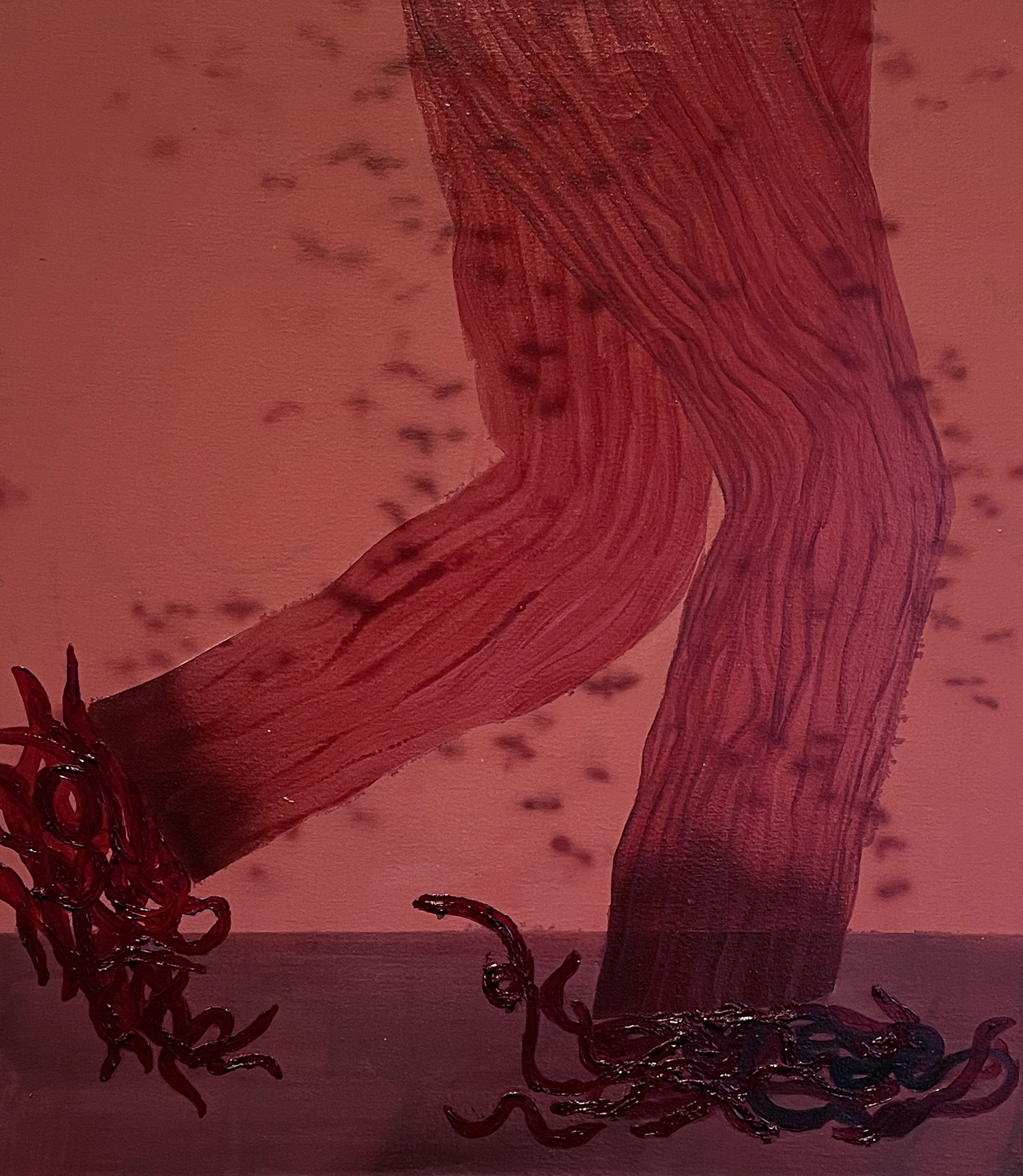
Snake boots
70x60cm, oil on canvas
2023
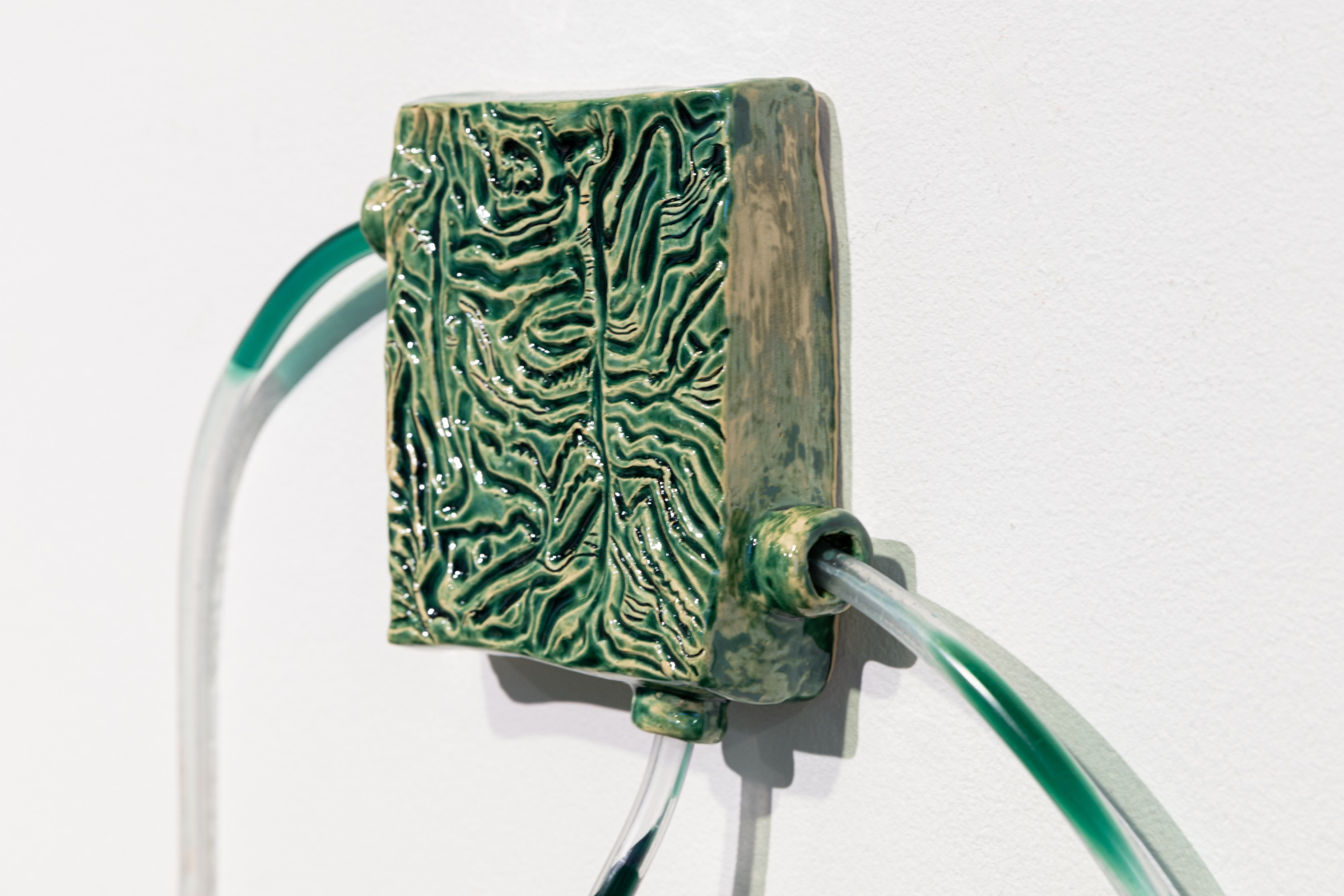
Canals (detail)
50x30x5cm, glazed stoneware, plastic, epoxy, glass
2023
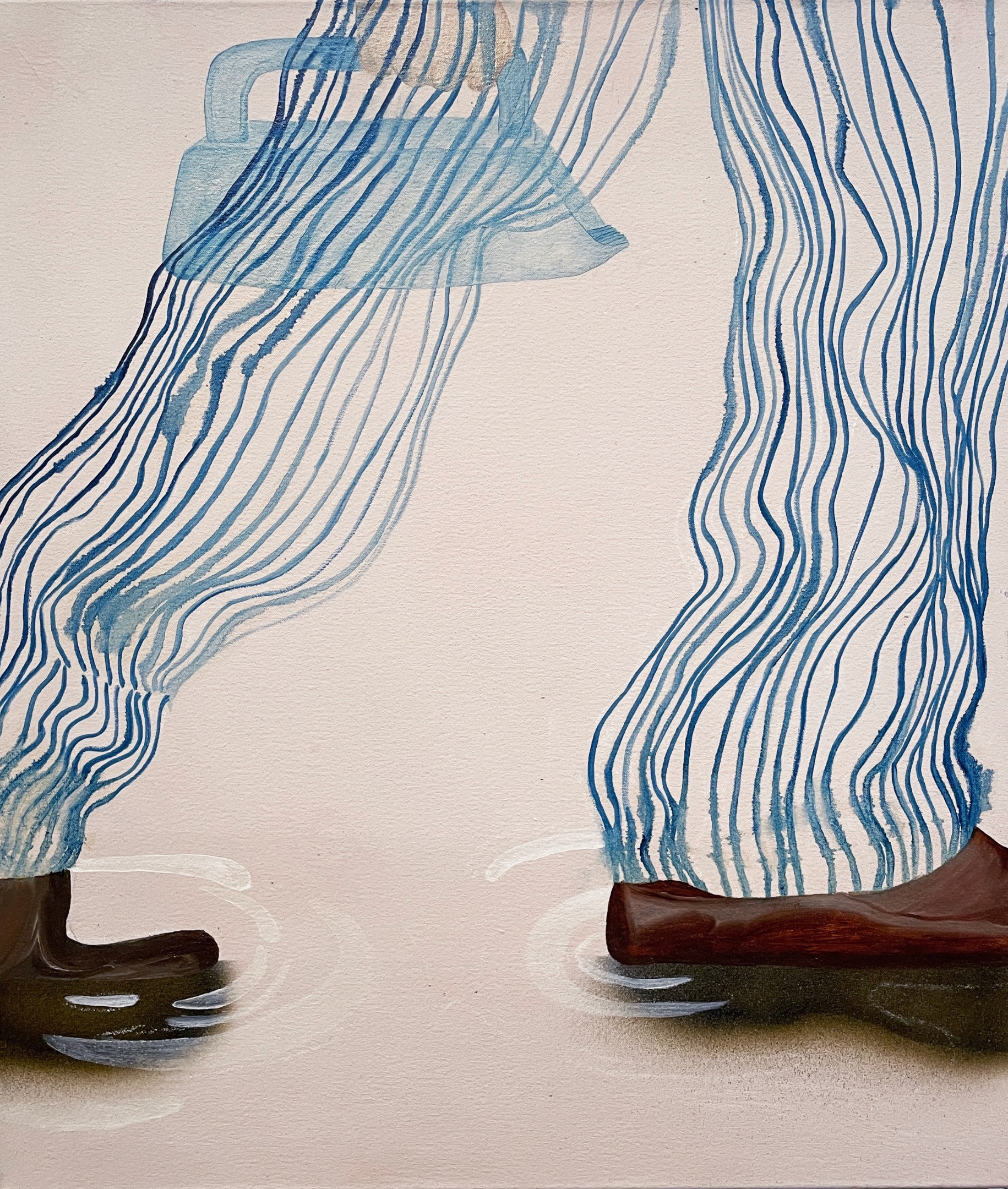
Puddle
70x60cm, ink and oil on canvas
2023

Berry Clean-up Tray
170x130cm, öljy kankaalle, oil on canvas
2023
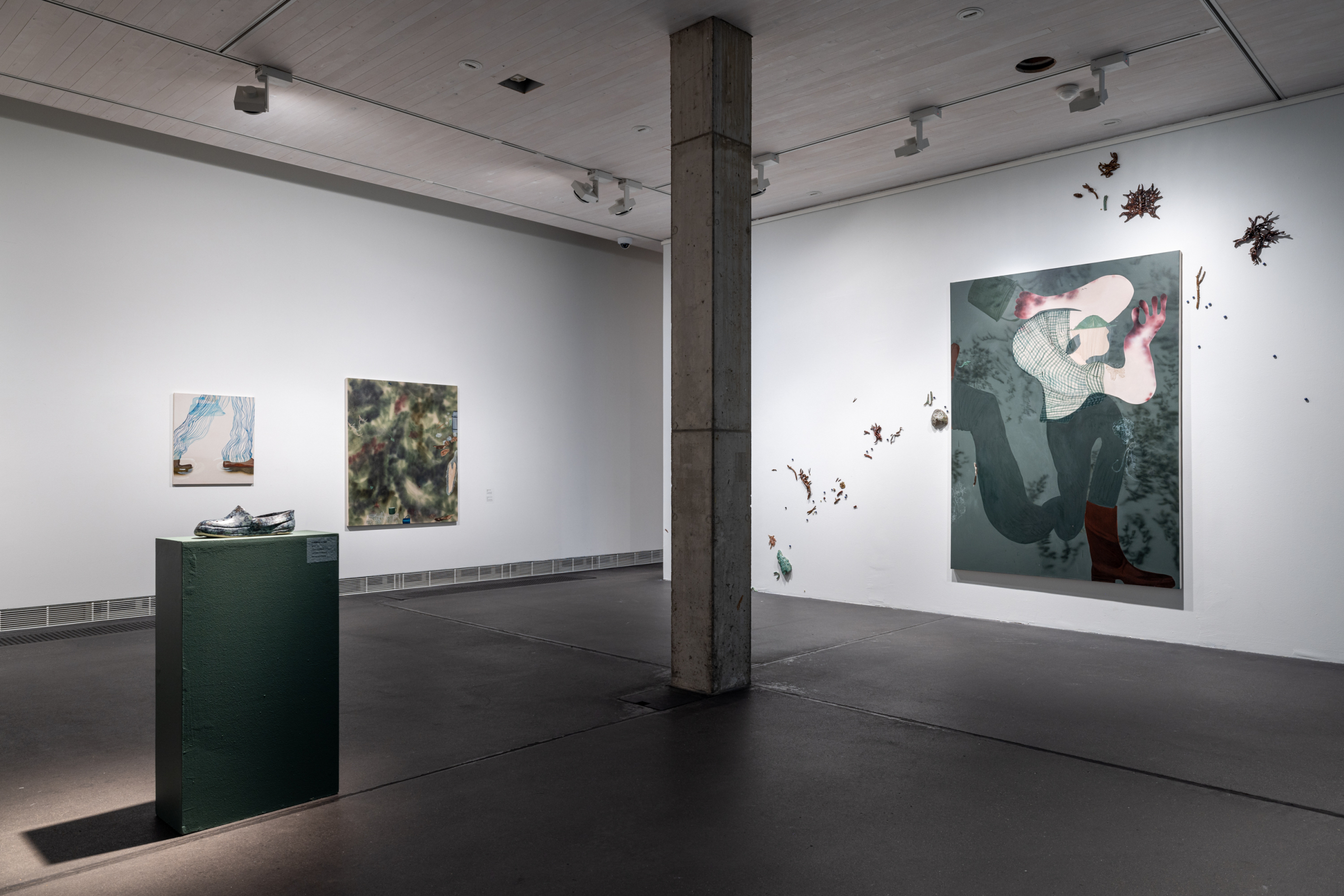
Installation view. Photo: Tatu Kantomaa

Forager
220x160cm, acrylic and oil on canvas
2023. Detail. Photo: Timo Nieminen

Moons and Drops
42,5x32,5cm, Yellow Bedstraw, Dyer's Woad, Meadowsweet, rabbit glue
2022

Ornament
70x60cm, acrylic and oil on canvas
2022

Squinter
32,5x28cm, Dyer's Woad, Heather, rabbit glue
2022

Sticks and Cones
64x60cm, ink and oil on canvas
2022

Process
45x55cm, ink and oil on canvas, glass
2023

Containers
170x140cm, acrylic and oil on canvas
2023
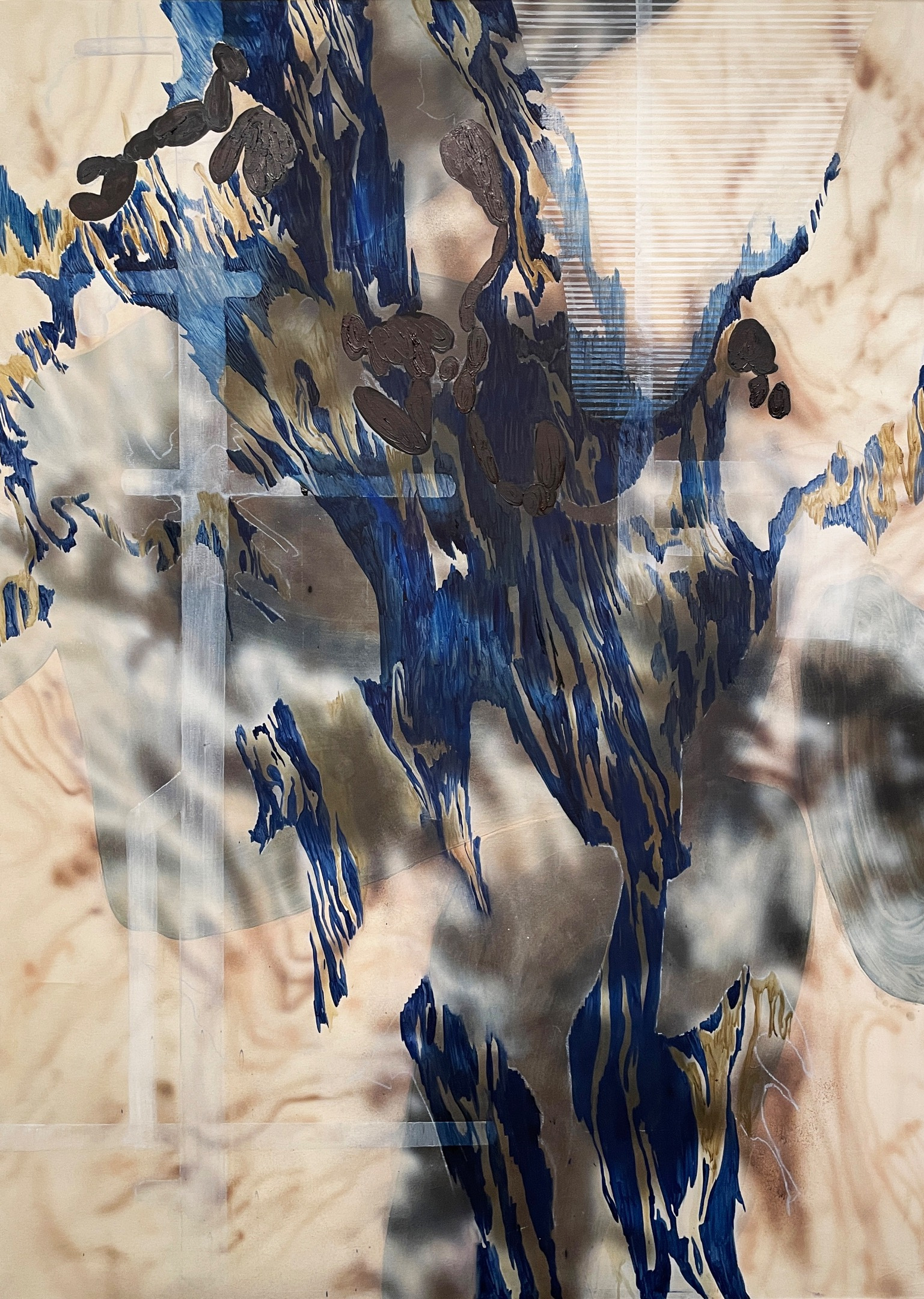
The Strata of the Earth
166x121cm, acrylic and oil on canvas
2022

Installation view. Photo: Tatu Kantomaa

Self Portrait
220x157cm, acrylic, ink and oil on canvas,
2023.
Cap
21x13x6cm, glazed stoneware
2023. Photo: Tatu Kantomaa

Moisture Accumulation
80x60cm, ink and oil on canvas
2021

Installation view

Extracts, The European Spruce Bark Beetle (detail)
15x130x10cm, glazed stoneware, plastic, glass
2023

In the Bog
200x160cm, ink and oil on canvas
2023

Bog illusion
260x320x10cm, glass, metal, epoxy, glazed stoneware, acrylic, the dwarf birch, Hevosenpäärimpi 25.6.23; hare's-tail cottongrass, Pyhälatva-aapa 24.6.23; baby tooth moss, Pyhälatva-aapa 24.6.23; marsh horsetail, Joutsenpesäaapa 24.6.23 small red peat moss, Pietarijänkä 23.6.23; bog cranberry, Tuohiaapa 22.6.23; red bogmoss, Pietarijänkä 23.6.23
2023

Leaf (detail)
84x74cm, acrylic and oil on canvas, glass
2023

Lingon Berries and Needles
70x60cm, oil on canvas
2023

Trashy Lingon Berries
70x60cm, oil on canvas
2023

Extracts, Leatherleaf (detail)
100x30x6cm, glazed stoneware, plastic, glass, epoxy leatherleaf flowers, -stems and -leaves
2023

Mosquito cloud
42,5x32,5cm, acrylic and oil on canvas
2022
Hanna Kanto: Forager
Korundi 22.9.2023–21.1.2024
Hanna Kanto's work explores new perspectives into the relationship between the people and nature of the North. The exhibition weaves together the ecological, economic, and mundane world with the spiritual, mystical, and strange. The results are surrealistic scenes of Finnish forests seen through the poetic language of painting and sculpture.
The exhibition is a continuation of Kanto's previous body of work, which examined the natural processes and environmental changes occuring in the North through a scientific gaze. Her current work expands on this perspective in a kaleidoscopic manner – highlighting the role and agency that humans play in the landscape. Kanto’s work blurs natural and industrial themes with abstract elements, as well as scientific apparatus – which reveal our complex entanglement with nature, and particularly our attitude toward exploiting its resources.
Kanto's work is concerned with exposing us to alternative perspectives and possibilities – the paintings act as macroscopic views into the forest, revealing the perspective of a small critter discovering manmade materials, trash, and berries amongst the moss. They can also be understood as everyday scenes of forest surfaces: A dapple of light filtering through the tangle of branches and fir, shimmering against the surface of the berry-picking rake or one’s rubber wellies. In Kanto's paintings, the northern forest reveals itself as a hybrid between the material and the mythical, into which the viewer is immersed and allowed to wander.
The current ecological and ideological debate on the treatment and fate of our forest and bogland is increasingly heated and polarised. Kanto uses this public discussion and research literature as a starting point into examining the conflicts and questions raised by these issues. Her primary material however, comes from intimate experiences and observations growing up in a family of forest owners and avid berry pickers.
Kanto has studied the art of transforming natural and organic matter into the materials of painting and sculpture. She describes gaining a tangible connection to nature when roots, plants, and mineral samples are refined into pigment or sculptural installations. She is interested in exploring the essence of materiality, and the variety of colour one is able to extract with chemical processes.
Hanna Kanto (b. 1981) is an artist from Tornio, Northern Finland, who currently lives and works in Helsinki. Kanto graduated with a Master's degree in Art from the University of Lapland in 2007 and a Master's degree in Fine Arts from the Academy of Fine Arts Helsinki in 2022. She has lived and worked in various parts of Lapland, the Norrbotten region, as well as in France. She has held numerous solo and group shows in Finland and abroad. Hanna Kanto mainly works in painting, but she also has an affinity to ceramics –sometimes incorporating these sculptural elements into her paintings, and at other times, letting them stand as independent works– serving as wall reliefs or three-dimensional forms in the gallery space.
Skilled Painting and Sweat in the Cloudberry Bog
Text: Sanna Lipponen
Eager eyes search for small, plump, amber clouds. Hands reach out again and again for the clusters of cloudberries growing upon the hummocks. Rubber wellies sink down into the wet bog, bodies become hunched over. Berry juice runs down the fingers, and sweat drips down the nose from beneath hats and mosquito nets. The hum of insects is so pervasive that one barely notices anymore. All that matters is that one berry after another makes its way from hummock to hand, from hand to bucket.
Hanna Kanto's works convey the passion and fervor ignited by berry picking – spending all day foraging in the cloudberry bog, with the berries still dancing before one's eyes even at bedtime. In her paintings, berry pickers crouch and leap forward, limbs stretching and sinking as they grasp for the familiar cloudberries, bilberries, and lingonberries. Through foraging, Kanto captures juicy angles into the prosaic and unique relationship that Finns have with nature.
Kanto has long drawn inspiration from northern nature in her artistic endeavors. Her earlier work was more directly connected to depicting her daily living and surrounding nature, and based on depictions of the landscape. After having the opportunity of tagging along in the fieldwork of a scientific research group, she began viewing these familiar landscapes from a new perspective – that of the microscope and the lens of natural science. Since then, her wanderings in the forest – as well as her paintings – have blossomed into more intricate and multidimensional forms. At its core still lies the northern nature: appreciating and sensing that which surrounds us.
The Many Meanings of Foraging
Plants frozen in epoxy resin, nestled amongst tiny bubbles – cranberries, cottongrass, sphagnum moss, bog labrador tea, and dwarf birch, collected by Kanto for her artworks – are like timecapsules from the past preserved in amber. Beyond the names of these plants, are the evocative names of the places where they were collected: Swan’s Nest Bog, Holy Treetop Bog, Peter’s Fen, and Horsehead Bog Eye. I haven't visited any of these places, but as I look at the plants, I feel that they hold within them some essence of these locations. Perhaps the plants remember and carry with them the scents of the bog, the sunlight, wind, and rain, which nourished them before being plucked out and preserved inside plastic.
Kanto draws eye-opening parallels between foraging and collecting plants for specimens; both are examples of human interaction with nature through gathering. While swinging the berry picker with blue-stained fingers and lips is a means of acquiring sustenance, collecting scientific specimens serves the purpose of expanding knowledge and understanding.
By following the language of painting, one discovers more intuitive openings, different compared to the analytical collecting of specimens. Yet both are ways of existing in this world — attempts to make sense, explore, and gain insight. In Kanto's works, the natural sciences present not only through plant and mineral specimens, but also as the presence of laboratory equipment, which take on new roles and meanings when the strange glass flasks and plastic tubing enter into a dialogue with her paintings and ceramic sculptures.
Deeper into the Forest through Mixing
The tubes depicted in Kanto's paintings and as actual tubes that act as sculptural elements in her ceramic works allude to the transfer of fluids from one place or entity to another. Through activities such as foraging, collecting samples, extracting, sucking, or transferring substances, Kanto illuminates human actions, but also the porous and flowing nature of life – how everything is not only in constant motion, but interconnected as well.
Emanuele Coccia writes in his book The Life of Plants: A Metaphysics of Mixture about how philosophy has relegated plants to the sidelines, being treated as a kind of "cosmic ornament," despite them being the foundation of our existence and life. Coccia aims to illustrate the perpetual entanglement of things, as seen, for example, in every inhalation and exhalation. Life and nature are constantly happening.
According to Coccia, this interchange or mixing also occurs on an intellectual level: "In the world, everything mixes with everything else, and nothing is ontologically separate from anything else. This also applies to knowledge and ideas. In the sea of thought, everything communicates with everything; every piece of knowledge penetrates all the others and is pierced by all the others" (Coccia, 2020, p. 116).
This fundamental blending is evident in Kanto's works on multiple levels. In her paintings, the berry and the berry picker meld into each other: the picker's hands and lips turn bilberry blue, and the cloudberry picker’s feet become golden bubbles. Kanto stretches and distorts the figure and scale of her subjects, exaggerates, plays with, and squeezes them into gestural forms. The paintings are both imaginative and intentional.
Her painterly expression swings back and forth between the figurative and the abstract; meanders down one route, then veers off in another direction, is always in search of a new path. A sense of porosity, translucency, and breathability can be experienced in the paintings, coexisting alongside the painter's use of precise and disciplined lines. Familiar organic shapes—larvae nests, cavities, cocoon cradles, or underground tunnels – encounter tight grid lines, pipes and tubing of the juice press. Such contrasts, parallels, and contradictions make the paintings endlessly captivating.
Likewise the viewer is enthralled by the wide scope of materials and tools intrinsic to Kanto’s way of working. Kanto employs an airbrush and paints with pigments made from plants and minerals, as well as, oil and acrylic. The paintings sometimes escape beyond the canvas' edges and transform into three-dimensional ceramic elements. In installations, plastic tubes and glass flasks, or small ceramic sculptures and airbrush paintings mutate into unique ecosystems of forest and bog landscape.
It is fascinating to follow how Kanto’s work is expanding outward, following its own way down new and unfamiliar forest paths. Even though the exhibition encompasses numerous shades, levels, tools, and forms of expression, the whole remains intentional and cohesive. Multiple visual and thematic connections, transitions and bridges between the separate works invite the viewer to approach and examine closer. At the same time, they offer new perspectives and paths for us to delve deeper into the forest—and merge with it.
References:
Emanuele Coccia: The Life of Plants: A Metaphysics of Mixture. Original title: La vie des plantes. Une métaphysique du mélange. Finnish translation by Jussi Palmusaari. 153 pages. Tutkijaliitto 2020.
Link to the article in Finnish
https://editmedia.fi/hallittua-maalausta-ja-hikea-hillasuolla/